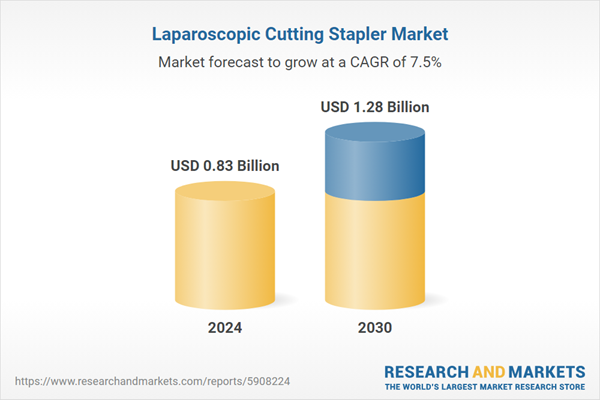Speak directly to the analyst to clarify any post sales queries you may have.
10% Free customizationThis report comes with 10% free customization, enabling you to add data that meets your specific business needs.
One key advantage of the laparoscopic cutting stapler is its precision in tissue dissection. The sharp cutting edge allows surgeons to make controlled incisions, ensuring accuracy and efficiency, especially in complex surgeries that require precise removal of damaged or diseased tissue. Additionally, the stapler incorporates a stapling mechanism, allowing surgeons to securely close tissues, creating a strong seal that is essential for procedures involving resection and anastomosis, thus minimizing the risk of leaks or complications post-surgery.
The use of laparoscopic cutting staplers also reduces operating times compared to traditional suturing techniques, as the stapler streamlines both the cutting and sealing processes. This enhances surgical efficiency, reduces the time patients spend under anesthesia, and optimizes the use of surgical resources. Furthermore, the minimally invasive nature of laparoscopic surgery, combined with the precision of the stapler, results in reduced trauma to surrounding tissues. This leads to less pain, shorter hospital stays, and faster recovery times for patients.
Laparoscopic cutting staplers are utilized across a variety of surgical specialties, including general surgery, gynecology, urology, and gastrointestinal surgery, contributing to their widespread adoption in surgical practices worldwide.
Key Market Drivers
Rising Prevalence of Chronic Diseases Requiring Surgical Intervention
The growing prevalence of chronic diseases, which often require surgical intervention, is a significant driver of the global laparoscopic cutting stapler market. As the global burden of obesity, gastrointestinal disorders, cancer, and other chronic conditions increases, the demand for minimally invasive surgeries (MIS) that rely on laparoscopic cutting staplers continues to rise. Obesity, for example, has reached epidemic levels, leading to a rise in bariatric surgeries like gastric bypass and sleeve gastrectomy, which extensively use laparoscopic staplers for efficient tissue sealing and reduced leakage risks.Key Market Challenges
High Initial Investment Costs
A major challenge facing the widespread adoption of laparoscopic cutting staplers is the high initial investment cost. These advanced surgical instruments require a substantial financial commitment for acquisition, training, and infrastructure, which may be a barrier for healthcare facilities, especially those with limited budgets. This financial burden is particularly pronounced for smaller healthcare centers or clinics, as well as those transitioning from traditional open surgery to laparoscopic techniques. Such costs may slow the adoption of minimally invasive surgical methods, particularly in resource-constrained regions.Key Market Trends
Shift Toward Single-Incision Laparoscopic Surgery (SILS)
The rise of Single-Incision Laparoscopic Surgery (SILS) is significantly influencing the laparoscopic cutting stapler market. SILS involves performing an entire surgical procedure through a single small incision, typically at the navel, offering numerous advantages such as reduced tissue trauma, less postoperative pain, and faster recovery times. As SILS becomes more popular, the demand for specialized laparoscopic cutting staplers designed for single-incision procedures has increased. Manufacturers are responding by developing staplers tailored for SILS, optimized for the unique challenges of this technique. This trend has expanded the range of surgeries that can be performed with greater precision and ease, driving the need for adaptable cutting staplers.Key Market Players
- Johnson & Johnson Services, Inc.
- Medtronic Plc.
- B. Braun Medical Inc.
- Intuitive Surgical Inc.
- CONMED Corp.
- Meril Life Sciences Pvt Ltd.
- Grena AS
- Reach Surgical Inc.
- Purple Surgical Holdings Ltd.
- Changzhou Ankang Medical Instruments Co., Ltd.
Market Segmentation
By Type:
- Thermal Cutting Stapler
- Cold Cutting Stapler
By Application:
- Hospitals & Clinics
- Ambulatory Centers
- Other
By Region:
- North America (United States, Canada, Mexico)
- Asia-Pacific (China, India, South Korea, Australia, Japan)
- Europe (Germany, France, United Kingdom, Spain, Italy)
- South America (Brazil, Argentina, Colombia)
- Middle East & Africa (South Africa, Saudi Arabia, UAE)
Competitive Landscape
This report provides a detailed analysis of major companies in the global laparoscopic cutting stapler market, including company profiles, financials, and strategic initiatives.Available Customizations
TechSci Research offers customizations to the Global Laparoscopic Cutting Stapler Market report based on specific needs. The following custom options are available:
- Detailed analysis and profiling of additional market players (up to five).
This product will be delivered within 1-3 business days.
Table of Contents
Companies Mentioned
- Johnson & Johnson Services, Inc.
- Medtronic Plc.
- B Braun Medical Inc
- Intuitive Surgical Inc
- CONMED Corp
- Meril Life Sciences Pvt Ltd
- Grena AS
- Reach Surgical Inc
- Purple Surgical Holdings Ltd
- Changzhou Ankang Medical Instruments Co.,Ltd
Table Information
| Report Attribute | Details |
|---|---|
| No. of Pages | 180 |
| Published | February 2025 |
| Forecast Period | 2024 - 2030 |
| Estimated Market Value ( USD | $ 0.83 Billion |
| Forecasted Market Value ( USD | $ 1.28 Billion |
| Compound Annual Growth Rate | 7.4% |
| Regions Covered | Global |
| No. of Companies Mentioned | 10 |









